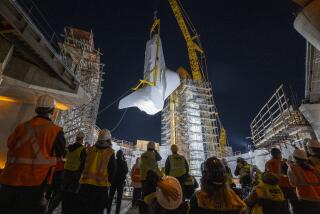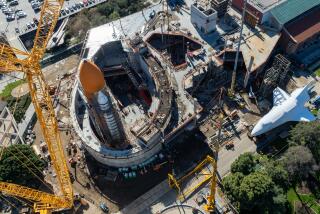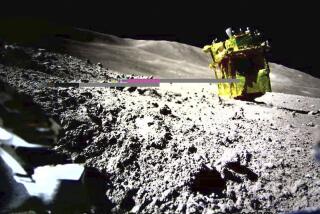A Good Catch for Japanese Shuttle Flier
KENNEDY SPACE CENTER, Fla. — A Japanese astronaut sent into orbit aboard the space shuttle Endeavour retrieved his country’s science satellite Saturday after its wayward wings were clipped.
Koichi Wakata used the shuttle’s robot arm to haul the gleaming, 4-ton satellite--minus its two solar-panel wings--into the shuttle’s cargo bay.
“Koichi’s got it, Houston,” shuttle commander Brian Duffy said.
“Congratulations on a great grab,” a Houston ground controller told Endeavour’s crew. The satellite holds experiments that will be evaluated when the satellite is returned to Japan.
Japan’s new prime minister, Ryutaro Hashimoto, and other dignitaries called Endeavour to congratulate Wakata.
*
“We were actually getting a little nervous, but thanks to you the mission was successful,” said Hidenao Nakagawa, Japanese minister of state for science and technology.
The capture 290 miles above the Gulf of Mexico, at an orbital speed of 17,500 mph, ended several hours of tension on Endeavour and in two control centers on opposite sides of the world.
It was the primary objective of NASA’s nine-day mission and of extreme importance to the Japanese space program, eager to get back its satellite and experiments after 10 months aloft.
The rendezvous ran into delays when the satellite’s electricity-generating solar panels folded up but failed to lock into place, possibly because of balky motors.
Japanese engineers working from a control center outside Tokyo tried everything to salvage the 32-foot-long panels--the spacecraft is designed to be reusable--while critical battery power drained.
*
Finally, after more than an hour, Japanese controllers decided to jettison the $8.6-million panels, a situation for which everyone had trained before the flight. The panels were severed by ground command and floated away, the latest additions to Earth’s orbital junkyard.
Wakata, a member of the shuttle’s six-person crew, snared the satellite using the shuttle’s 50-foot robot arm at 2:57 a.m. PST. He then poised the satellite over the orbiter’s payload bay and slowly lowered it onto a platform there.
The maneuver was completed when the satellite was latched down at 3:39 a.m. It was the first time a spacecraft launched by one country was retrieved by another for return to Earth.
The octagonal satellite, which looks like a giant sunflower in Endeavour’s cargo bay, was rocketed into space from a launch site in Japan in March on a mission valued at nearly $700 million.
It contains dead Japanese red-bellied newts, newt eggs, crystal-growth furnaces and an infrared telescope, among other things.
The astronauts, who already have had to dodge a defunct Air Force satellite, won’t have to worry about running into the drifting solar panels. Endeavour dove to a lower, safer orbit following Saturday’s retrieval.
The astronauts are scheduled to release a U.S. science satellite today. A pair of spacewalks are scheduled for later in the week.
Endeavour’s landing is set for Saturday.
More to Read
Sign up for Essential California
The most important California stories and recommendations in your inbox every morning.
You may occasionally receive promotional content from the Los Angeles Times.










